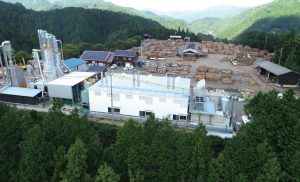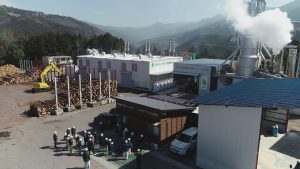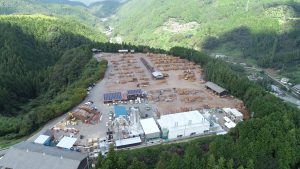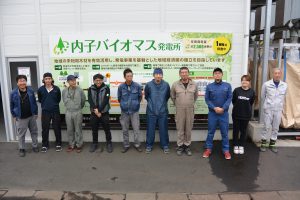森林とまちの活力を創造する!内子バイオマス発電所 / Revitalizing Forest and Town! Uchiko Biomass Power Plant / 创造森林和城镇的活力! 内子生物质发电厂
内子バイオマス発電所は2018年10月竣工、2019年から本格稼働し、同年4月から四国電力に売電を開始、2021年10月からみんな電力へも売電を開始しました。現在では1年間で一般家庭約2500戸分の電力に相当する約1000kWを発電。森林率約77%である内子町の森林資源を活用した、地域密着型バイオマス発電として注目されています。
※世帯当たり3,254.4kWh/年で算出(出典:電気事業連合会「原子力・エネルギー図画集2015」)

■中央の白い建物が内子バイオマス発電所、その左がペレット製造のプラントです
豊かな森林資源を誇る内子町ですが、人工林は放置された状態が続くと、良質な木材が生産できないばかりか、森林の保水力が弱まったり、表土流出や土砂崩れを起こしたりするなどの危険が高まります。適度な伐採、間伐などが行われることが必要ですが、木材価格の低迷による木材生産の低下とともに、間伐後に回収されなかったり、曲がっているなどの理由で廃棄されたりする未利用材の活用が課題となっていました。
そこで、内子町バイオマスタウン構想のもと、地元の有限会社内藤鋼業が未利用材を活用して木質ペレットを製造し、公共施設のペレットストーブやボイラーなどで利用する取組が始まりました。しかし、冬に需要が限定されてしまうことが課題となり、年間を通して安定供給するために、ペレットによる発電所が構想されたといいます。内子バイオマス発電所は、内藤鋼業を中心に地元の企業が出資、地元金融機関が融資し、シン・エナジー株式会社(神戸市)の設計・施工によって建設されました。ペレットの原料となる原木の供給は、隣接する内子森林組合が担っています。

■視察も受け入れています
木質ペレットの製造にはいくつもの工程があります。まず、原木をチッパーと呼ばれる機械で細かいチップにします。そのままでは水分が多いため、木の皮などを燃やして作った温風で乾燥させ、さらに細かく砕いておが粉にします。おが粉をペレット製造機に入れ、ぎゅっと押し固めて粒状のペレットが作られます。
そして、隣接するバイオマス発電所では、ガス化装置でペレットから発生させたガスを燃料に、発電装置のエンジンを動かして発電します。発電時に出る温水から、温水発電も行っています。
また、ペレット製造時にチップを乾燥させるために燃やす木の皮などから発生する灰は、セメントなどを加えてバイオマスストーンとして再生され、林道の舗装などに活用しています。
ペレットの原料となる原木を集める仕組みにも工夫があります。それが町営の「木こり市場プロジェクト」。出荷者が軽トラで未利用材を森林組合の収集場所へ持ち込むと、1トンあたり8000円で買い取ってもらうことができ、そのうちの5000円は現金で、残りの3000円は地域の50ほどの店舗で使える地域通貨「ドン券」で受け取ります(令和4年3月現在)。令和2年度は576.6トンの出荷があったそうです。このように比較的高額の買い取り価格が設定され、出荷が促されて安定的に原木を入手できるとともに、地域でお金が循環する仕組みが定着しています。
これらの取組が高く評価され、内子バイオマス発電所は令和2年度新エネ大賞(新エネルギー財団会長賞)「地域共生部門」に輝きました。

■内子森林組合に隣接しています
海外に依存する化石燃料を使う発電は、CO2を排出し、地球温暖化の原因になっています。一方、木質バイオマス発電は自然資源からつくられる再生可能エネルギーであり、発電時にCO2が排出されますが、森林で樹木が生育するときにCO2を吸収することから、全体として見れば大気中のCO2の量に影響を与えないので、カーボンニュートラルとされます。また、内子バイオマス発電所は海外や遠い地域から森林資源を購入するのではなく、隣接する内子町内の森林から生じる未利用材を活用することから、運搬などによるCO2の排出や労力などを最小限に抑えることができます。また、森林資源の購入資金が外の地域に流出せずに域内で再投資されることにより、地域の活性化につながります。さらに、地域における森林資源の需要が高まることによって、どんどん森林に人の手が入って整備が進み、健全な森林が保たれ、防災や水の涵養の機能も高まります。このようにプラスの循環が生まれ、町の活性化が進むことが期待されています。

■内子バイオマス発電所の運営を担う皆さん
2022年4月には、町内の龍王地区で「内子龍王バイオマス発電所」が着工予定となっています。内藤鋼業が製造する木質ペレットを使った発電とともに、副産物として発生する熱を温浴施設とフィットネスクラブに供給するコジェネプラントが建設される計画で、内子町におけるバイオマス発電の横展開が始まっています。内子バイオマス発電所は随時見学を受け付けているので、森林資源活用による再生可能エネルギーが創出される現場を体感することができます。
【事業主】内子バイオマス発電合同会社
愛媛県喜多郡内子町寺村2478-1
https://www.symenergy.co.jp/service/area_energy/uchiko/
【運営管理】有限会社内藤鋼業
http://naito-kogyo.co.jp/
Revitalizing Forest and Town! Uchiko Biomass Power Plant
The Uchiko Biomass Power Plant finished construction in October 2018 and came online in 2019. It began selling electricity to Shikoku Electric Power Company in April of the same year, and to Minna Denryoku in October 2021. Currently it produces about 1,000 kW of electricity, or roughly the amount needed to power about 2,500 homes over one year. It is garnering attention as a form of community-based biomass power generation that effectively utilizes the resources of Uchiko Town, which is 77% forest.
*Calculated based on a figure of 3,254.4 kWh/year for one household (Source: Federation of Electric Power Companies, “Graphical Flip-chart of Nuclear & Energy Related Topics, 2015”)
■The white building in the center is the biomass power plant. To its left is the pellet production plant.
Though Uchiko Town boasts abundant forest resources, when planted forests are left alone for too long not only do they stop producing high-quality lumber, the risks of reduced water retention, topsoil runoff and landslides also increase. Moderate logging and thinning is necessary, but the decline in lumber production due to falling prices, along with what to do with wood that wasn’t collected after thinning or that was discarded for various reasons such as being bent, was becoming an issue.
And so, under the Uchiko Town Biomass Town Plan, the local company Naito Kogyo Co., Ltd. began utilizing the unused wood to make wood pellets, for use in pellet stoves and boilers in public facilities. However, the problem was that demand for this was limited to winter. In order to stabilize it throughout the year, a plan to make a pellet-powered power plant was devised. The Uchiko Biomass Power Plant was designed and constructed by SymEnergy Co., Ltd. (Kobe), with investments from local companies — centering around Naito Kogyo — and financing by local financial institutions. The adjoining Uchiko Forest Association is responsible for providing the raw lumber used to make the pellets.
■The plant also accepts inspections.
Producing the wood chips involves a number of processes. First, raw lumber is fed into a machine called a “chipper” and ground into fine chips. Because the water content is high, these chips are dried with warm air currents from burning tree bark and other waste materials, and then further processed into sawdust. Finally, the sawdust is run through a pellet-making machine, which presses and hardens it into granular pellets.
At the adjoining biomass power plant, gas is extracted from the pellets using a gasifier, which is used to fuel an engine generator and produce electricity. The hot water created as a byproduct is used to generate electricity, too.
Additionally, the ash generated during the drying stage of the pellet production process is added to cement and other materials and recycled as biomass stone, which is used as pavement for things like forest roads.
There is also a clever system for gathering the lumber used as raw materials for the pellets. Namely, the municipal “Lumberjack Market Project.” Shippers take unused materials to the Forest Association collection site via light truck, and the Association will buy it for 8,000 yen per ton: 5,000 yen to be paid in cash, and the remaining 3,000 yen to be paid as “Don Coupons” useable at around 50 local retailers (as of March 2022). In 2020, there were 576.6 tons shipped. In this way, a relatively high purchase price is established, promoting shipments and providing a stable source of raw lumber, while at the same time creating a system for money to circulate within the community.
In recognition of these initiatives, the Uchiko Biomass Power Plant was awarded the 2020 New Energy Award (New Energy Foundation Chairman’s Award) in the “community coexistence” category.
■The Uchiko Forest Association is adjacent.
Power generation using fossil fuels, which are dependent on foreign countries, produces CO2 which causes global warming. On the other hand, wood biomass power generation creates renewable energy from natural resources, and although it also emits CO2 it is considered carbon neutral because that CO2 is absorbed when trees grow in the forest, meaning that when looked at from a broader point of view there is no net addition to the overall level of CO2 in the atmosphere. In addition, because the Uchiko Biomass Power Plant does not purchase forest resources from distant regions or overseas, but rather utilizes unused resources from the forests around Uchiko Town, the CO2 emissions and labor associated with transportation are minimized. And, because the funds for the purchase of forest resources are reinvested in the community instead of being diverted to other regions, it also contributes to the revitalization of the region. Further, by increasing demand for regional forest resources, people will tend to the forests more, keeping them healthy and helping to prevent disasters and increase water cultivation. This in turn creates a positive feedback loop, which will hopefully lead to the revitalization of the town, as well.
■The management of the Uchiko Biomass Power Plant.
The Uchiko Ryuo Biomass Power Plant is scheduled to begin construction in Uchiko’s Ryuo District in April 2022. There are also plans to begin horizontal expansion, such as building a cogeneration plant which will divert the waste heat created when generating electricity with Naito Kogyo’s wood pellets, and use it to heat a public bath facility and fitness club. Tours of the Uchiko Biomass Power Plant are available upon request, so visitors can experience firsthand the process of generating renewable electricity by utilizing forest resources.
[Owner] Uchiko Biomass Power LLC
2478-1 Teramura, Uchiko-cho, Kita-gun, Ehime-ken
https://www.symenergy.co.jp/service/area_energy/uchiko/
[Operator] Naito Kogyo Co., Ltd.
创造森林和城镇的活力! 内子生物质发电厂
内子生物质发电厂于2018年10月竣工,并于2019年开始全面运营,同年4月开始向四国电力销售电力。自2021年10月起,该厂还开始向株式会社UPDATER(旧MINNA电力株式会社)出售电力。目前,该厂每年发电约1000 kW,相当于约2500户家庭的电力需求。该生物质发电厂利用内子町森林资源的77%,成为备受关注的地方紧密型生物质发电厂。
* 每户相当于 3,254.4 kWh /年的计算(资料来源:日本电气事业联合会,“核电与能源图画书 2015”)
■中间的白色建筑是内子生物质发电厂,左边是颗粒制造厂。
内子町虽然拥有丰富的森林资源,但如果继续放置人工林,不仅无法生产出高质量的木材,而且森林的保水能力也将减弱,表土流失或山体滑坡等风险也将会增加。 适当的伐木和疏伐是必要的,但随着木材价格低迷导致木材产量下降,活用疏伐后未收集或因弯曲或其他原因而被丢弃的未使用的木材已成为了一个课题。
因此,在内子町生物质城镇的概念下,当地的有限会社内藤钢业活用未使用的木材制造了木屑颗粒,并将其用于公共设施的颗粒炉和锅炉。 然而,仅限于只有冬季才需要的事实成为了课题,为了确保全年的稳定供应,构想了一个使用木屑颗粒的发电厂。 内子生物质发电厂由新能源株式会社(神户市)设计・施工并建造,内藤钢业为首的当地企业投资,当地金融机构融资。 用作颗粒原料的原木由相邻的内子林业协会负责供应。
■接受视察
木屑颗粒的生产涉及几个过程。 首先,用削片机的机器将原木制成细木片。 由于水分很多,因此用燃烧木皮等而产生的暖空气来干燥,然后将其粉碎成细块制成锯末。 将锯末放入制粒机中挤压制成颗粒。
然后,在相邻的生物质发电厂,用气化炉装置将颗粒产生的气体作为燃料,驱动发电机组的发动机使其发电。 我们还利用发电过程中产生的热水,进行热水发电。
此外,在颗粒制造过程中用于燃烧的木皮和其他材料产生的灰烬,通过添加水泥和其他材料作为生物质石回收,用于铺设林道。
还有一种收集原木的机制,原木是木屑颗粒的原料。 这就是城镇上经营的“伐木工人市场项目”。 当出货人用轻型卡车将未使用的木材带到林业合作社的收集点时,他们可以以每吨8,000日元的价格出售,其中5,000日元为现金,其余3,000日元以「礼品券」的形式收款,这是一种地区货币,可以在该地区的约50家商店使用(令和4年3月现在)。 在令和2年,出货量为576.6吨。 通过这种方式,设定了相对较高的购买价格,并鼓励发货以确保稳定收购原木,并在该地区生根发芽。
这些努力得到了高度评价,内子生物质发电厂获得了“地区共生部门”的令和2年新能源奖(新能源财团会长奖)。
■毗邻内子林业合作社
使用依赖海外的化石燃料发电会排放二氧化碳,成为全球变暖的原因。另一方面,木质生物质发电利用再生能源从自然资源中制造,发电时会排放二氧化碳,但由于森林生长时吸收二氧化碳,因此从整体上看对大气中的二氧化碳含量没有影响,被认为是碳中和的。此外,内子生物质发电厂不是从海外或遥远地区购买森林资源,而是利用毗邻的内子町未利用的森林资源,可以将由于运输等导致的二氧化碳排放和劳动力等降到最低限度。此外,由于森林资源购买的资金不会流向外部地区,而是在该地区再投资,这有助于促进地方经济的活性化。此外,随着对森林资源的需求增加,森林中将越来越多地投入人力,整个森林得以保持健全,增强防灾和补水的功能。因此,可以期待产生积极的循环,推动城镇的活力。
■负责运营内子生物质发电厂的人们
2022年4月,在该城镇的龙王区计划建设「内子龙王生物质发电厂」。 除了使用内藤钢业制造的木屑颗粒发电外,还计划建设一个热电联产工厂,该热电联产工厂将作为副产品产生的热量提供给热水浴设施和健身俱乐部,并且已经开始在内子町横向扩展生物质发电。 内子生物质发电厂随时可接受参观,因此您可以在现场体验利用森林资源创造的可再生能源。
【企业主】内子生物质发电有限责任公司
爱媛县北郡内子町寺村2478-1
https://www.symenergy.co.jp/service/area_energy/uchiko/
【运营管理】有限公司内藤钢业



